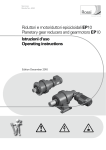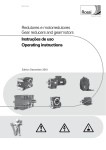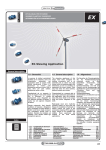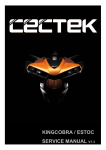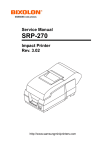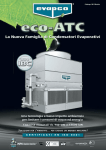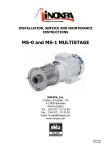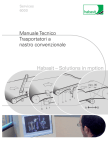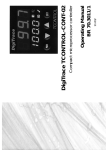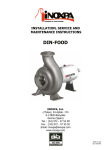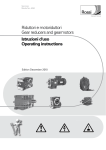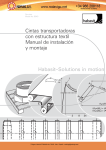Download Riduttori e motoriduttori epicicloidali EP02 Planetary gear
Transcript
Services Media No. 4088 Riduttori e motoriduttori epicicloidali EP02 Planetary gear reducers and gearmotors EP02 Istruzioni d'uso Operating instructions Edition May 2011 Istruzioni d'uso per riduttori e motoriduttori epicicloidali EP02 Indice 1 - Avvertenze generali sulla sicurezza 3 2 - Condizioni di funzionamento 3 3 - Stato di fornitura 3 3.1 3.2 3.3 3.4 - Ricevimento Targa di identificazione Verniciatura Protezioni e imballo 3 3 3 3 4 - Immagazzinamento 4 5 - Installazione 4 5.1 5.2 5.3 5.4 5.5 5.6 - Generalità Sensi di rotazione Montaggio di organi sulle estremità d’albero Fissaggio pendolare Albero cavo con unità di bloccaggio Unità autonoma di raffreddamento 4 5 5 5 6 6 Riciclaggio (tenere presente le prescrizioni in vigore): – gli elementi della carcassa, gli ingranaggi, gli alberi e i cuscinetti del riduttore devono essere trasformati in rottami d’acciaio. Gli elementi in ghisa grigia subiranno il medesimo trattamento nella misura in cui non esiste alcuna prescrizione specifica; – le ruote a vite sono realizzate in bronzo e devono essere trattate di conseguenza; – gli oli esausti dovranno essere recuperati e trattati conformemente alle prescrizioni. I paragrafi contrassegnati dal simbolo qui a lato contengono disposizioni da osservare tassativamente onde garantire l’incolumità delle persone ed evitare danni rilevanti alla macchina o all’impianto (es: lavori effettuati sotto tensione, su apparecchi di sollevamento, ecc.); I’installatore o il manutentore deve comunque attenersi scrupolosamente a tutte le istruzioni contenute nel presente manuale. 1 - Avvertenze generali sulla sicurezza I riduttori e i motoriduttori epicicloidali presentano parti pericolose in quanto possono essere: – poste sotto tensione; – a temperatura superiore a 50 °C; – in movimento durante il funzionamento. Un’installazione non corretta, un uso improprio, la rimozione delle protezioni, lo scollegamento dei dispositivi di protezione, la carenza di ispezioni e manutenzione, i collegamenti impropri, possono causare danni gravi a persone o cose. Pertanto, il componente deve essere movimentato, installato, messo in servizio, gestito, ispezionato, manutenuto e riparato esclusivamente da personale responsabile qualificato (definizione secondo IEC 364). Si raccomanda di attenersi a tutte le istruzioni del presente manuale, alle istruzioni relative all’impianto, alle vigenti disposizioni legislative di sicurezza, e a tutte le normative applicabili in materia di corretta installazione. Componenti in esecuzione speciale o con varianti costruttive possono differire nei dettagli rispetto a quelli descritti e possono richiedere informazioni aggiuntive. Per eventuali chiarimenti e/o informazioni ulteriori, interpellare Rossi, specificando tutti i dati di targa. I riduttori e i motoriduttori del presente manuale sono normalmente destinati ad essere impiegati in aree industriali: protezioni supplementari eventualmente necessarie per impieghi diversi devono essere adottate e garantite da chi è responsabile dell’installazione. –a lla Direttiva macchine 2006/42/CE; –a lla Direttiva «Compatibilità elettromagnetica (EMC)» 2004/ 108/CE e successivi aggiornamenti. Per l’installazione, I’uso e la manutenzione del motore elettrico (normale, autofrenante o comunque speciale) o dell’eventuale motovariatore e/o apparecchiatura elettrica di alimentazione (convertitore di frequenza, soft-start ecc.), consultare la documentazione specifica Istruzioni d'uso 6 - Lubrificazione 6 6.1 - Generalità 6.2 - Cuscinetti con lubrificazione indipendente, cuscinetti motore 6 6 7 - Messa in servizio 6 8 - Manutenzione 7 8.1 - Generalità 8.2 - Anelli di tenuta 8.3 - Sostituzione motore IT 7 7 7 9 - Anomalie: cause e rimedi 7 10 - Rev. 1 - Edition May 2011 14 EN ad essi allegata. All’occorrenza richiederla. Qualunque tipo di operazione sul riduttore (motoriduttore) o su componenti ad esso connessi deve avvenire a macchina ferma: scollegare il motore (compresi gli equipaggiamenti ausiliari) dall’alimentazione, il riduttore dal carico e assicurarsi che si siano attivati i sistemi di sicurezza contro ogni avviamento involontario e, ove si renda necessario, prevedere dispositivi meccanici di bloccaggio (da rimuovere prima della messa in servizio). In caso di funzionamento anomalo (aumento di temperatura, rumorosità inusuale, ecc.) arrestare immediatamente la macchina. I prodotti relativi a questo manuale corrispondono al livello tecnico raggiunto al momento della stampa del manuale stesso. Rossi si riserva il diritto di apportare, senza preavviso, le modifiche ritenute opportune per il miglioramento del prodotto. 2 - Condizioni di funzionamento I riduttori sono progettati per utilizzo in applicazioni industriali in accordo con i dati di targa, temperatura ambiente 0 +40 °C (con punte a -10 °C e +50 °C), altitudine massima 1 000 m. Non è consentito l’impiego in atmosfere aggressive, con pericolo di esplosione, ecc. Le condizioni di funzionamento devono corrispondere ai dati di targa. 3 - Stato di fornitura 3.1 - Ricevimento Al ricevimento verificare che la merce corrisponda a quanto ordinato e che non abbia subito danni durante il trasporto; nel caso, contestarli immediatamente allo spedizioniere. Evitare di mettere in servizio riduttori o motoriduttori danneggiati anche solo lievemente. 3.2 - Targa di identificazione Ogni riduttore è dotato di targa di identificazione di alluminio anodizzato contenente le principali informazioni tecniche relative alle caratteristiche funzionali e costruttive e ne definisce, assieme agli accordi contrattuali, i limiti applicativi (ved. fig. 1); la targa non deve essere rimossa, e deve essere mantenuta integra e leggibile. Tutti i dati riportati in targa devono essere specificati sugli eventuali ordini di parti di ricambio. 3.3 - Verniciatura I prodotti sono verniciati con vernice sintetica idonea a resistere ai normali ambienti industriali e a consentire ulteriori finiture con vernice sintetiche; colore blu RAL 5010 DIN 1843. Protezione interna con vernice epossidica idonea a resistere agli oli minerali o sintetici a base di poliafaolefine. 3.4 - Protezioni e imballo Le estremità libere degli alberi sporgenti e gli alberi cavi vengono protetti con olio antiruggine di lunga durata e con cappellotto (solo fino a D 48 mm per alberi sporgenti, D 110 mm per alberi cavi) in materiale plastico (polietilene). Tutte le parti interne sono protette con olio antiruggine. Se non concordato diversamente in sede d’ordine, i prodotti vengono adeguatamente imballati: su pallet, protetti mediante pellicola 4088INS.EPL-it0511HQM Rossi 3 Designazione (ved. tabella a lato) Bimestre e anno di costruzione Esecuzioni speciali Forma costruttiva (se diversa da IM B5) Potenza motore Fattore di servizio motoriduttore Velocità di uscita motoriduttore Rapporto di trasmissione R, MR R, MR Prodotto Esecuzione 2E, 3E, 4E 200 ... 696 FC ... CE, C2E, C3E 200 ... 696 FO ... Coassiali Ortogonali Ø Flangia - albero motore Potenza nominale riduttore IT Designazione Macchina Rotismo Grand. Fig. 1 (per maggiori indicazioni, ved. documentazione tecnica specifica). Nota: A decorrere dal 04/05/2010 la società già ROSSI MOTORIDUTTORI S.p.A. ha assunto la denominazione sociale Rossi S.p.A. e la targa è stata aggiornata. EN di polietilene, nastrati e reggiati (grandezze superiori); in cartonpallet nastrati e reggiati (grandezze inferiori); in cartoni nastrati (per piccole dimensioni e quantità). All’occorrenza i riduttori sono convenientemente separati con cellule di schiuma antiurto o cartone da riempimento. I prodotti imballati non devono essere accatastati l’uno sull’altro. 4 - Immagazzinamento L’ambiente deve essere sufficientemente pulito, secco, esente da vibrazioni eccessive (veff 0,2 mm/s) per non danneggiare i cuscinetti (tale necessità di contenere le vibrazioni, pur se entro limiti più ampi, deve essere soddisfatta anche durante il trasporto) e a una temperatura di 0 +40 °C: sono ammesse punte di 10 °C in meno o in più. Ruotare semestralmente gli alberi di qualche giro per prevenire danneggiamenti a cuscinetti e anelli di tenuta. In ambienti normali e purché vi sia stata una adeguata protezione durante il trasporto, il componente viene fornito per un periodo di immagazzinamento fino a 1 anno. Per un periodo di immagazzinamento fino a 2 anni in ambienti normali è necessario seguire le seguenti ulteriori disposizioni: – ingrassare abbondantemente le tenute, gli alberi e le eventuali superfici lavorate non verniciate, controllando periodicamente lo stato di conservazione dell’olio antiruggine; – riempire completamente i riduttori con l’olio di lubrificazione riportandolo a livello prima della messa in servizio. Per immagazzinamento con durata superiore ai 2 anni o in ambiente aggressivo o all’aperto, interpellare Rossi. 5 - Installazione 5.1 - Generalità Prima di effettuare l’installazione, verificare che: –n on vi siano stati danni durante l’immagazzinamento o il trasporto; – I’esecuzione sia adeguata all’ambiente (temperatura, atmosfera, ecc.); – I’allacciamento elettrico (rete o altro) corrisponda ai dati di targa del motore; – la forma costruttiva di impiego corrisponda a quella indicata in targa. Per il fissaggio del riduttore alla macchina azionata: Coassiali Attenzione! Per il sollevamento e la movimentazione del riduttore o del motoriduttore utilizzare i fori passanti della carcassa riduttore, accertarsi che il carico sia convenientemente bilanciato e che siano disponibili apparecchiature di sollevamento, sistemi di aggancio e cavi di portata adeguata. All’occorrenza l’entità delle masse dei riduttori e dei motoriduttori è indicata sulla documentazione tecnica specifica. Assicurarsi che la struttura sulla quale viene fissato il riduttore o il motoriduttore sia piana, livellata e sufficientemente dimensionata per garantire la stabilità del fissaggio e l’assenza di vibrazioni (sono accettabili velocità di vibrazione veff 3,5 mm/s per PN 15 kW e veff 4,5 mm/s per PN > 15 kW), tenuto conto di tutte le forze trasmesse dovute alle masse, al momento torcente, ai carichi radiali e assiali. Per le dimensioni delle viti di fissaggio dei piedi riduttore e la profondità dei fori filettati consultare i cataloghi tecnici Rossi. Attenzione! La durata dei cuscinetti e il buon funzionamento di alberi e giunti dipendono anche dalla precisione dell’allineamento tra gli alberi. Pertanto, occorre prestare la massima cura nelI’allineamento del riduttore con il motore e con la macchina da comandare (se necessario, spessorare), interponendo se opportuno giunti adeguati. Non utilizzare, per il sollevamento dei motoriduttori, i golfari del motore. Collocare il riduttore o il motoriduttore in modo da garantire un ampio passaggio d’aria per il raffreddamento e del riduttore e del motore (soprattutto dal lato ventola motore). Evitare: strozzature nei passaggi dell’aria; vicinanza con fonti di calore che possano aumentare la temperatura dell’aria di raffreddamento e del riduttore (per irraggiamento); insufficiente ricircolazione d’aria e in generale applicazioni che compromettano il regolare smaltimento del calore. Montare iI riduttore o motoriduttore in modo che non subisca vibrazioni. Le superfici di fissaggio (del riduttore e della macchina) devono essere pulite e di rugosità sufficiente a garantire un buon coefficiente di attrito: asportare con un raschietto o con solvente l’eventuale vernice delle superfici di accoppiamento del riduttore. In presenza di carichi esterni impiegare, se necessario, spine o arresti positivi. Per le dimensioni delle viti di fissaggio consultare la documentazione tecnica specifica. B5 V1 – impiegare bulloneria di classe 8.8 o superiore seguendo le prescri- V3 Classe di bulloneria Grand. M2 picco 0,71 MN21) M2 picco 0,71 MN21) servizio con urti e servizio normale servizio con urti e carichi alterni carichi alterni 241, 354 8.8 10.9 10.9 428, 445, 542 355, 429, 10.9 10.9 12.9 446, 543 445 ... 696 con 8.8 10.9 10.9 fissaggio con piedi UT.C. 966 Ortogonali zioni riportate nella tabella seguente; B5 B51 B52 B53 V1 V3 UT.C. 968 – s errare le viti, mediante chiave dinamometrica, con momento di serraggio pari a 0,7 volte il limite di snervamento; – sfruttare tutti i fori previsti sulla flangia e le spine elastiche preinserite; – verificare il momento di serraggio dopo le prime ore di funzionamento; – per riduttori grand. 354 con estremità d’albero cilindrica o scanalata e carico radiale 0,71 Fr2max1) utilizzare il secondo centraggio N0 (consigliata la tolleranza H7). 1) Ved. documentazione specifica. Le viti di classe 10.9 devono essere munite di rosetta, per aumen- 4 Rossi Istruzioni d'uso 4088INS.EPL-it0511HQM ti, anelli elastici o altre parti. Per accoppiamenti H7/m6, K7/k6 e K7/m6 è consigliabile effettuare il montaggio a caldo riscaldando l’organo da calettare fino a 80 100 °C. Per gli accoppiamenti scanalati impiegare adeguati prodotti contro l’ossidazione tipo MOLYKOTE, Klüber o LOCTITE. I giunti con velocità periferica sul diametro esterno fino a 20 m/s de-vono essere equilibrati staticamente; per velocità periferiche superiori occorre effettuare l’equilibratura dinamica. IT tare la superficie di appoggio della testa della vite medesima. Per grand. 445, 446 le viti di fissaggio devono essere del tipo a cava esagonale (TCEI) per garantire la necessaria accessibilità alla chiave dinamometrica. Nelle viti di fissaggio tra riduttore e macchina, si raccomanda l’impiego di adesivi bloccanti tipo LOCTITE. Prima di effettuare l’allacciamento del motoriduttore assicurarsi che la tensione del motore corrisponda a quella di alimentazione; se il senso di rotazione non corrisponde a quello desiderato, invertire due fasi della linea di alimentazione. Quando l’avviamento è a vuoto (o comunque a carico molto ridotto) ed è necessario avere avviamenti dolci, correnti di spunto basse, sollecitazioni contenute, adottare l’avviamento Y-. Nel caso si prevedano sovraccarichi di lunga durata, urti o pericoli di bloccaggio, installare salvamotori, limitatori elettronici di momento torcente, giunti idraulici, di sicurezza, unità di controllo o altri dispositivi similari. Per servizi con elevato numero di avviamenti a carico è consigliabile la protezione del motore con sonde termiche (incorporate nello stesso); il relé termico non è idoneo, in quanto dovrebbe essere tarato a valori superiori alla corrente nominale del motore. Limitare i picchi di tensione dovuti ai contattori mediante l’impiego di varistori. Quando una perdita accidentale di lubrificante può comportare gravi danni, aumentare la frequenza delle ispezioni e/o adottare accorgimenti opportuni (es.: indicatore a distanza di livello, lubrificante per industria alimentare, ecc.). In presenza di ambiente inquinante, impedire in modo adeguato la possibilità di contaminazione del lubrificante attraverso gli anelli di tenuta o altro. Per installazione all’aperto o in ambiente aggressivo verniciare il riduttore o il motoriduttore con vernice anticorrosiva, proteggendolo eventualmente anche con grasso idrorepellente (specie in corrispondenza delle sedi rotanti degli anelli di tenuta e delle zone di accesso alle estremità dell’albero). Quando è possibile, proteggere il riduttore o il motoriduttore con opportuni accorgimenti dall’irraggiamento solare e dalle intemperie: quest’ultima protezione diventa necessaria quando gli assi lento o veloce sono verticali o quando il motore è verticale con ventola in alto. Per funzionamento a temperatura ambiente maggiore di 40 °C o mi-nore di 0 °C interpellare Rossi. 5.2 - Sensi di rotazione La relazione fra i sensi di rotazione in entrata e in uscita, per tutti i riduttori sia coassiali sia ortogonali, è schematizzata nelle figure seguenti. Fig. 2 Estremità d’albero cilindrica D Ø 28 ... 40 42, 50 48 60 ... 100 110 120 ... 170 190, 200 100 EN d Ø M M M M M M M 101) 161) 161) 201) 143) 163) 166) 1) M 22 per grand. CE 241 ... 354, C2E 354 ... 445, C3E 445 ... 543. 110 Estremità d’albero scanalata D S d1) Ø B40x36 B50x45 B58x53, B70x64 B80x74 B90x84, B100x94 W120x3 ... W200x5 M 6 M 8 M 10 M 12 M 14 M 16 1) N ° 3 fori a 120°, n° 6 fori a 60° per grand. 695, 696 Quando il collegamento tra riduttore e macchina o motore è realizzato con una trasmissione che genera carichi sull’estremità d’albero (ved. fig. 3), è necessario che: – non vengano superati i carichi massimi indicati a catalogo; – lo sbalzo della trasmissione sia ridotto al minimo; – le trasmissioni a ingranaggi non abbiano punti senza gioco; – le trasmissioni a catena non siano tese (all’occorrenza – carico e/o moto alterni – prevedere opportuni tendicatena); – le trasmissioni a cinghia non siano eccessivamente tese. UT.C 117 Errato Corretto Errato Corretto Fig. 3 5.3 - Montaggio di organi sulle estremità d’albero Per il foro degli organi calettati sulle estremità d’albero cilindriche (centraggi per estremità scanalate), si raccomanda la tolleranza H7; per estremità d’albero lento cilindrica, salvo che il carico non sia uniforme e leggero, la tolleranza deve essere K7. Prima di procedere al montaggio, pulire accuratamente e lubrificare le superfici di contatto per evitare il pericolo di grippaggio e l’ossidazione di contatto. Attenzione! ll montaggio e lo smontaggio devono essere effettuati con l’ausilio di tiranti e di estrattori servendosi dei fori filettati in testa all’estremità d’albero, avendo cura di evitare urti e colpi (ved. fig. 2) che potrebbero danneggiare irrimediabilmente cuscinet- Istruzioni d'uso 5.4 - Fissaggio pendolare Nel fissaggio pendolare il riduttore deve essere sopportato radialmente e assialmente (anche per forme costruttive B5 ... B53) dal perno della macchina e ancorato contro la sola rotazione mediante un vincolo libero assialmente e con giochi di accoppiamento sufficienti a consentire le piccole oscillazioni, sempre presenti, senza generare pericolosi carichi supplementari sul motoriduttore stesso. Si raccomanda l’impiego del braccio di reazione simmetrico rispetto all’asse lento del riduttore perché, in tal modo, la reazione al momento torcente viene ripartita equamente sui due vincoli senza caricare i cuscinetti della macchina. Lubrificare con prodotti adeguati le cerniere e le parti soggette a scorrimento; per il montaggio delle viti si raccomanda l’impiego di adesivi bloccanti tipo LOCTITE 601. In relazione al sistema di reazione, attenersi alle indicazioni di progetto indicate nella documentazione tenica specifica. In ogni caso, qualora vi siano pericoli per persone o cose derivanti da cadute o 4088INS.EPL-it0511HQM Rossi 5 proiezione del riduttore o di parti di esso, prevedere appropriate sicurezze contro: – la rotazione o lo sfilamento del riduttore dal perno macchina conseguenti a rotture accidentali del vincolo di reazione; – la rottura accidentale del perno macchina. IT EN 5.5 - Albero cavo con unità di bloccaggio Per il perno delle macchine sul quale va calettato l’albero cavo del riduttore, seguire le indicazioni riportate al paragrafo «Estremità d’albero cavo con unità di bloccaggio» nella documentazione tecnica specifica. Per il calettamento dell’unità di bloccaggio procedere come segue: – sgrassare accuratamente le superfici dell’albero cavo e del perno macchina da accoppiare; – montare l’unità di bloccaggio sull’albero cavo del riduttore avendo cura di lubrificare preventivamente la superficie esterna dell’albero cavo; – serrare leggermente un primo gruppo di tre viti disposte a circa 120° e montare il riduttore sul perno macchina; – serrare con chiave dinamometrica le viti dell’unità di bloccaggio, in modo graduale e uniforme, con sequenza continua (non in croce!) e in più fasi sino al raggiungimento del momento di serraggio prescritto (ved. tabella); – al termine delle operazioni verificare il momento di serraggio delle viti; – in presenza di cicli gravosi di lavoro, con frequenti inversioni del moto, verificare nuovamente, dopo alcune ore di funzionamento il momento di serraggio delle viti. Importante! Il diametro del perno della macchina in battuta contro il riduttore deve essere almeno pari a 1,18 1,25 volte il diametro interno dell’albero cavo. Attenzione! Per montaggi verticali a soffitto, e solo per riduttori dotati di anelli o bussola di bloccaggio, il sostentamento del riduttore è dovuto al solo attrito per cui è necessario prevedere un sistema di arresto. F H6/h6 1) 2) 42 50 75 85 100 110 130 140 160 170 190 200 M 688 M 868 M 810 M1098 M1210 M1212 M1610 M1614 M1615 M1620 M2015 M2018 1,2 3,2 3,2 6,2 10,2 10,2 25,2 25,2 25,2 25,2 49,2 49,2 D H F Ø M daN m 1) UNI 5737-88 cl. 10.9. 2) Momenti di serraggio. 5.6 - Unità autonoma di raffreddamento Ved. documentazione tecnica specifica fornita in dotazione con l’unità. 6 - Lubrificazione 6.1 - Generalità La lubrificazione degli ingranaggi è a bagno d’olio, quella dei cuscinetti è a bagno d’olio, a sbattimento o con grasso «a vita» (con o senza anello NILOS, secondo la velocità e la forma costruttiva). I riduttori sono forniti senza olio con un tappo di carico con valvola, un tappo trasparente di livello ed eventualmente, in funzione della forma costruttiva, della velocità entrata e del tipo di servizio, di un serbatoio d’espansione olio. Pertanto, prima della messa in servizio, occorre: – verificare che il riduttore venga montato nella forma costruttiva prevista all’ordine, che è indicata sulla targa; quando non è indicata, il riduttore è previsto per essere montato in forma costruttiva orizzontale B5; – immettere fino a livello olio minerale (AGIP Blasia, ARAL Degol BG, BP Energol GR XP, KLÜBER Klüberoil GEM1, MOBIL Mobilgear 600XP, MOBIL Mobilgear XMP, SHELL Omala S2 G, TOTAL Carter EP) avente la gradazione di viscosità ISO indicata in tabella. Qualora si desideri aumentare l’intervallo di lubrificazione («lunga vita»), il campo della temperatura ambiente e/o ridurre la temperatura dell’olio impiegare olio sintetico (a base di polialfaolefine: AGIP Blasia SX, ARAL Degol PAS, BP Enersyn EPX, KLÜBER Klübersynth GEM4, MOBIL Mobilgear SHC XMP, SHELL Omala S4 GX, TOTAL Carter EP SH) avente la gradazione di viscosità ISO indicata in tabella. 6 Rossi Istruzioni d'uso La quantità di lubrificante da immettere è quella che consente il raggiungimento del livello segnalato dall’apposito tappo trasparente – a riduttore non in moto – e non quella, solo indicativa, menzionata a catalogo. Gradazione di viscosità ISO Valore medio [cSt] della viscosità cinematica a 40 °C. Velocità n1 min-1 1 180 1 180 300 300 Temperatura ambiente1) [°C] olio minerale olio sintetico 0 20 10 40 0 40 150 220 320 220 320 460 150 220 320 1) S ono ammesse punte di temperatura ambiente di 10 °C (20 °C per olio sintetico) in meno o 10 °C in più. Orientativamente l’intervallo di lubrificazione, in assenza di inquinamento dall’esterno, è quello indicato in tabella. Per sovraccarichi forti dimezzare i valori. Temperatura olio [°C] Intervallo di lubrificazione [h] olio minerale olio sintetico 65 65 80 80 95 5 600 12 500 2 800 9 000 1 400 6 300 Indipendentemente dalla durata di funzionamento, provvedere alla sostituzione dell’olio: – ogni 1 2 anni per olio minerale; – ogni 2 4 anni per olio sintetico. Non miscelare oli sintetici di marche diverse; se per il cambio dell’olio si vuole utilizzare un tipo di olio diverso da quello precedentemente impiegato, effettuare un accurato lavaggio. Ogni riduttore è dotato di targa di lubrificazione. Gruppi motoriduttori. La lubrificazione è indipendente e pertanto valgono le norme dei singoli riduttori. 6.2 - Cuscinetti con lubrificazione indipendente, cuscinetti motore I cuscinetti sono normalmente lubrificati in modo automatico e continuo (a bagno d’olio o a sbattimento) dal lubrificante stesso del riduttore. Tuttavia per certi riduttori in forma costruttiva verticale V1, V3 e orizzontale B51, B52 i cuscinetti superiori hanno lubrificazione indipendente, con grasso speciale per lubrificazione «a vita» in assenza di inquinamento dall’esterno; questo vale anche per i cuscinetti motore (esclusi alcuni casi nei quali è previsto il dispositivo di rilubrificazione). In caso di possibilità di inquinamento del grasso o in presenza di determinati servizi è bene verificare (tra un cambio dell’olio e l’altro oppure ogni 1 o 2 anni) lo stato del grasso e asportare e sostituire (ogni 1 o 2 cambi oppure ogni 2 o 4 anni) il grasso nei cuscinetti con lubrificazione indipendente. Il cuscinetto deve essere riempito completamente con grasso per cuscinetti: MOBIL MOBILITH SHC 460 per cuscinetti a sfere, KLÜBER STABURAGS NBU 8 EP per cuscinetti a rulli. 7 - Messa in servizio Effettuare un controllo generale assicurandosi, in particolare, che il riduttore sia completo di lubrificante fino a livello e che sia montato nella forma costruttiva indicata in targa. In caso della prima messa in servizio, prima di procedere al normale ciclo di lavoro, è opportuno che il riduttore sia posto in funzione in assenza di carico per verificare il corretto funzionamento. In tale circostanza, causa l’eliminazione di eventuali sacche d’aria residue, potrebbe rendersi necessario un rabbocco di olio per conseguire il corretto riempimento fino a livello. Nel caso di avviamento Y-, la tensione di alimentazione deve corrispondere a quella più bassa (collegamento ) del motore. Per il motore asincrono trifase, se il senso di rotazione non corrisponde a quello desiderato, invertire due fasi della linea di alimentazione. Rodaggio: affinché si possa raggiungere la massima funzionalità operativa, è consigliabile eseguire un ciclo di rodaggio per una durata di circa 50 100 h, al termine del quale occorre verificare il momento di serraggio dei bulloni di fissaggio. Dopo 500 1 000 h di funzionamento sostituire l’olio. 4088INS.EPL-it0511HQM 8 - Manutenzione 8.1 - Generalità A macchina ferma, controllare periodicamente (più o meno frequentemente secondo l’ambiente e l’impiego): a)la pulizia delle superfici esterne e dei passaggi d’aria di ventilazione del riduttore o del motoriduttore, in modo da non pregiudicare lo smaltimento del calore; b)le regolari condizioni di funzionamento: – livello e grado di deterioramento dell’olio (controllare a riduttore fermo e freddo); – rumorosità; – vibrazioni; – tenute; – corretto serraggio delle viti di fissaggio; – ecc. Attenzione! Dopo un periodo di funzionamento, il riduttore è soggetto a una lieve sovrapressione interna che può causare fuoriuscita di fluido ustionante. Pertanto, prima di allentare i tappi (di qualunque tipo compreso quello di carico) attendere che il riduttore si sia raffreddato e aprire con cautela; diversamente avvalersi di opportune protezioni contro il contatto accidentale con l’olio caldo. In ogni caso, procedere sempre con la massima attenzione. Le massime temperature dell’olio, indicate nella tabella dell’intervallo di lubrificazione non sono pregiudizievoli per il buon funzionamento del riduttore. Durante l’operazione di cambio dell’olio, dopo avere svitato anche il tappo di carico per favorire lo svuotamento, è raccomandabile lavare internamente la carcassa del riduttore utilizzando lo stesso tipo di olio impiegato per il funzionamento. Per il successivo riempimento, impiegare un filtro per olio con 60 m di potere filtrante. È sempre opportuno sostituire gli anelli di tenuta nel caso in cui vengano smontati o in occasione delle revisioni periodiche del riduttore; in tal caso, il nuovo anello deve essere collocato in modo che il filo di tenuta non lavori sulla stessa pista di scorrimento dell’anello precedente. 8.2 - Anelli di tenuta La durata dipende da molti fattori, quali velocità di strisciamento, temperatura, condizioni ambientali, ecc.; orientativamente può variare da 1 600 12 500 h. 8.3 - Sostituzione motore Poiché i motoriduttori sono realizzati con motore normalizzato, la sostituzione del motore – in caso di avaria – è facilitata al massimo. È sufficiente osservare le seguenti norme: – assicurarsi che i motori abbiano gli accoppiamenti lavorati in classe precisa (UNEL 13501-69; DIN 42955); – pulire accuratamente le superfici di accoppiamento; – controllare la linguetta, in modo che tra la sua sommità e il fondo della cava del foro ci sia un gioco di 0,1 0,2 mm; se la cava sull’albero è uscente, spinare la linguetta; – lubrificare la superficie di accoppiamento contro l’ossidazione di contatto. Istruzioni d'uso 9 - Anomalie: cause e rimedi Anomalia Possibili cause Lubrificazione inadeguata: Eccessiva temperatura – olio in quantità eccessiva o (di regime o insufficiente dei cuscinetti) – lubrificante inadatto (tipolo gia, troppo viscoso, esausto, ecc.) – cuscinetti a rulli conici registrati troppo stretti – t emperatura ambiente eccessiva Rimedi Controllare: – il livello dell’olio (a riduttore fermo) – il tipo e/o stato del lubrificante Interpellare Rossi Aumentare il raffreddamento o correggere la temperatura ambiente IT Aperture di aspirazione del Pulire il copriventola copriventola ostruite Cuscinetti in avaria o mal lubri- Interpellare Rossi ficati o difettosi Sistema di raffreddamento dell’olio inefficiente o fuori servizio: filtro intasato, portata dell’olio (scambiatore) insufficiente, pompa fuori servizio, ecc. Rumorosità anomala Controllare la pompa, i condotti, il filtro dell’olio e l’efficienza degli indicatori di sicurezza (pressostati, termostati, flussostati, ecc.) Uno o più denti con: — ammaccature o sbeccature Interpellare Rossi — rugosità eccessiva sui fianchi Cuscinetti in avaria o mal lubri- Interpellare Rossi ficati o difettosi Cuscinetti a rulli conici con Interpellare Rossi gioco eccessivo Vibrazioni Perdita di lubrificante dagli anelli di tenuta Controllare il fissaggio Anello di tenuta con labbro di Sostituire l’anello di tenuta tenuta usurato, bachelizzato, danneggiato o montato erroneamente Sede rotante danneggiata Rigenerare la sede (rigatura, ruggine, ammaccattura, ecc.) Posizionamento in forma Orientare costruttiva diversa da quella riduttore prevista in targa correttamente il NOTA Quando si interpella Rossi, indicare: – tutti i dati di targa del riduttore o motoriduttore; – la natura e la durata dell’avaria; – quando e sotto quali condizioni l’avaria si è verificata; – nel periodo di validità della garanzia, per non farne decadere la validità, non eseguire smontaggi o manomissioni del riduttore in nessun caso senza l'autorizzazione di Rossi. 4088INS.EPL-it0511HQM Rossi 7 EN IT EN Pagina lasciata intenzionalmente bianca. This page is intentionally left blank. 8 Rossi Istruzioni d'uso 4088INS.EPL-it1210HQM Operating instructions for planetary gear reducers and gearmotors EP02 Index 1 - General safety instructions 9 2 - Operating conditions 9 3 - How supplied 9 3.1 3.2 3.3 3.4 - Receipt Name plate Painting Protections and packing 9 9 9 9 4 - Storing 10 5 - Installation 10 5.1 5.2 5.3 5.4 5.5 5.6 - General Directions of rotation Fitting of components to shaft ends Shaft-mounting Hollow shaft with shrink disc Independent cooling unit 10 11 11 11 12 12 6 - Lubricant 6.1 - General 6.2 - Bearing with independent lubrication, motor bearings 12 12 12 7 - Commissioning 12 8 - Maintenance 13 8.1 - General 8.2 - Seal rings 8.3 - Motor replacement IT 13 13 13 9 - Troubles: causes and corrective actions 13 10 - Rev. 1 - Edition May 2011 14 EN Recycling (keeping in mind the instructions in force): – the elements of casing, gear pairs, shafts and bearings of gear reducer must be transformed into steel scraps. The elements in grey cast iron will be subjected to the same treatment if there is no particular instruction; – exhausted oils must be recycled and treated according to the instructions. The paragraphs marked with present symbol contain dispositions to be strictly respected in order to assure personal safety and to avoid any heavy damages to the machine or to the system (e.g.: works on live parts, on lifting machines, etc.); the responsible for the installation or maintenance must scrupulously follow all instructions contained in present handbook. When operating on gear reducer (gearmotor) or on components connected to it the machine must be at rest: disconnect motor (including auxiliary equipments) from power supply, gear reducer from load, be sure that safety systems are on against any accidental starting and, if necessary, pre-arrange mechanical locking devices (to be removed before commissioning). If deviations from normal operation occur (temperature increase, unusual noise, etc.) immediately switch off the machine. The products relevant to this handbook correspond to the technical level reached at the moment the handbook is printed. Rossi reserves the right to introduce, without notice, the necessary changes for the increase of product performances. 1 - General safety instructions Gear reducers and designed for industrial applications according to name plate data, at ambient temperature 0 +40 °C (with peaks at -10 °C and +50 °C), maximum altitude 1 000 m. Not allowed running conditions: application in aggressive environments having explosion danger, etc. ambient conditions must comply with specifications stated on name plate. Planetary gear reducers and gearmotors present dangerous parts because they can be: – live; – at temperature higher 50 °C; – rotating during the operation; An incorrect installation, an improper use, the removing or disconnection of protection devices, the lack of inspections and maintenance, improper connections may cause severe personal injury or property damage. Therefore the component must be moved, installed, commissioned, handled, controlled, serviced and repaired exclusively by responsible qualified personnel (definition to IEC 364). It is recommended to pay attention to all instructions of present handbook, all instructions relevant to the system, all existing safety laws and standards concerning correct installation. Components in non-standard design or with special executions or with constructive variations may differ in the details from the ones described here following and may require additional information. For any clarification and/or additional information consult Rossi and specify all name plate data. Gear reducers and gearmotors of present handbook are normally suitable for installations in industrial areas: additional protection measures, if necessary for different employs, must be adopted and assured by the person responsible for the installation. IMPORTANT: the components supplied by Rossi must be incorporated into machinery and should not be commissioned before the machinery in which the components have been incorporated conforms to: –M achinery directive 2006/42/EC; –« Electromagnetic compatibility (EMC)» directive 2004/108/ EC and subsequent updatings. For the installation, use and maintenance of the electric motor (standard, brake or non-standard motor) or of the possible motorvariator and/or the electric supply device (frequency converter, soft-start, etc.) consult the attached specific documentation. If necessary, require it. Operating instructions 2 - Operating conditions 3 - How supplied 3.1 - Receipt At receipt verify that the unit corresponds to the one ordered and has not been damaged during the transport, in case of damages, report them immediately to the courier. Avoid commissioning gear reducers and gearmotors, that are even if slightly damaged. 3.2 - Name plate Every gear reducer presents a name plate in anodised aluminium containing main technical information relevant to operating and constructive specifications and defining, according to contractual agreements, the application limits (see fig. 1); the name plate must not be removed and must be kept integral and readable. All name plate data must be specified on eventual spare part orders. 3.3 - Painting Products are painted with synthetic paint appropriate for resistance to normal industrial environments and suitable for the application of further coats of synthetic paint; colour blue RAL 5010 DIN 1843. Internal protection in synthetic paint appropriate for resistance to mineral oils or to polyalphaolefines synthetic oils. 3.4 - Protections and packing Overhanging free shaft ends and hollow shafts are treated with protective anti-rust long life oil and protected with a plastic (polyethylene) cap (only up to D 48 mm for overhanging shafts, D 110 mm for hollow shafts). All internal parts are protected with protective anti-rust oil. Unless otherwise agreed in the order, products are adequately packed: on pallet, protected with a polyethylene film, wound with adhesive tape and strap (bigger sizes); in carton pallet, wound with 4088INS.EPL-en0511HQM Rossi 9 Designation (see table on the right) Two months and year of manufacture Non-standard executions Mounting position (when differing from IM B3 or B5) Motor power Gearmotor service factor Gearmotor output speed IT Transmission ratio Designation Machine Train of gears Size R, MR R, MR Design 2E, 3E, 4E 200 ... 696 FC ... CE, C2E, C3E 200 ... 696 FO ... Product Coaxial Right angle shaft Ø Flange - motor shaft Gear reducer nominal power Fig. 1 (for more information, see Rossi technical catalogs; consult us). Note: Starting from 04/05/2010 the company name ROSSI MOTORIDUTTORI S.p.A. has been changed into Rossi S.p.A., and the nameplate has been updated accordingly. EN adhesive tape and strap (smaller sizes); in carton boxes wound with tape (for small dimensions and quantities). If necessary, gear reducers are conveniently separated by means of anti-shock foam cells or of filling cardboard. Do not stock packed products on top of each other. 4 - Storing Surroundings should be sufficiently clean, dry and free from excessive vibrations (veff 0,2 mm/s) to avoid damage to bearings (excessive vibration should also guarded during transit, even if within wider range) and ambient storage temperature should be 0 +40 °C: peaks of 10 °C above and below are acceptable. Every six months rotate the shafts (some revolutions are sufficient) to prevent damage to bearings and seal rings. Assuming normal surroundings and the provision of adequate protection during transit, the unit is protected for storage up to 1 year. For a 2 year storing period in normal surroundings it is necessary to pay attention also to following instructions: – generously grease the sealing, the shafts and the unpainted machined surfaces, if any, and periodically control conservation state of the protective anti-rust oil; – completely fill the gear reducers with lubrication oil and the specified level before commissioning. For storages longer than 2 years or in aggressive surroundings or outdoors, consult Rossi S.p.A.. 5 - Installation 5.1 - General Before the installation, verify that: – there were no damages during the storing or the transport; – design is suitable to the einvironment (temperature, atmosphere, etc.); – electrical connection (power supply, etc.) corresponds to motor name plate data; – used mounting position corresponds to the one stated in name plate. Coaxial type B5 V1 –a pply bolts and screws class 8.8 or higher following the instructions contained in the table; Bolts and screws class Size M2 peak 0,71 MN21) M2 peak 0,71 MN21) duty cycle with shocks standard duty cylce with shocks and alternate loads duty cycle and alternate loads 241, 354 8.8 10.9 10.9 428, 445, 542 355, 429, 10.9 10.9 12.9 446, 543 445 ... 696 8.8 10.9 10.9 foot-mounted V3 Right angle shaft type B5 Fitting of gear reducer to driven machine: – tighten the screws through dynamometric wrench with tightening UT.C. 966 Attention! When lifting and transporting the gear reducer or gearmotor use through holes of the gear reducer casing; be sure that load is properly balanced and provide lifting and coupling systems, and cables of adequate section. If necessary, gear reducer and gearmotor masses are stated in Rossi technical catalogues. Be sure that the structure on which gear reducer or gearmotor is fitted is plane, levelled and sufficiently dimensioned in order to assure fitting stability and vibration absence (vibration speed veff 3,5 mm/s for PN 15 kW and veff 4,5 mm/s for PN > 15 kW are acceptable), keeping in mind all transmitted forces due to the masses, to the torque, to the radial and axial loads. For the dimensions of fixing screws of gear reducer feet and the depth of tapped holes consult the Rossi technical catalogues. Attention! Bearing life and good shaft and coupling running depend on alignment precision between the shafts. Carefully align the gear reducer with the motor and the driven machine (with the aid of shims if need be), interposing flexible couplings whenever possible. Do not use motor eyebolts when lifting the gearmotors. Position the gear reducer or gearmotor so as to allow a free passage of air for cooling both gear reducer and motor (especially at their fan side). Avoid any obstruction to the air flow; heat sources near the gear reducer that might affect the temperature of cooling air and of gear reducer (for radiation); insufficient air recycle and applications hindering the steady dissipation of heat. Mount the gear reducer or gearmotor so as not to receive vibrations. Mating surfaces (of gear reducer and machine) must be clean and sufficiently rough to provide a good friction coefficient: remove by a scraper or solvent the eventual paint of gear reducer coupling surfaces. When external loads are present use pins or locking blocks, if necessary. For the dimensions of fastening screws consult the specific technical documentation. B51 B52 B53 V1 V3 torque equal to 0,7 times the upper yield strength; –u se all holes foreseen on flange and the pre-inserted elastic pins; – verify the tightening torque after the first hours of running; – for gear reducer size 354 with cylindrical or splined shaft end and radial load 0,71 Fr2max1) use a second spigot recess N0 (we advise tolerance H7). 1) See technical documentation. UT.C. 968 10 Rossi The screws class 10.9 must be equipped with washer in order to increase the bearing surfaces of the same screw head. For sizes 445, 446 use hexagonal socket head cap screws as fastening screws (TCEI) in order to grant the necessary accessibility to the dynamometric wrench. Operating instructions 4088INS.EPL-en0511HQM For splined couplings apply adequate products type MOLIKOTE, Klüber or LOCTITE. IT Fig. 2 Cylindrical shfat ends When fitting gear reducer and machine it is recommended to use locking adhesives such as LOCTITE on the fastening screws. Before wiring-up the gearmotor make sure that motor voltage corresponds to input voltage. If direction of rotation is not as desired, invert two phases at the terminals. Y- starting should be adopted for no-load starting (or with a very small load) and for smooth starts, low starting current or other similar devices should be fitted. If overloads are imposed for long periods or if shocks or danger of jamming are envisaged, then motor-protection, electronic torque limiters, fluid couplings, safety couplings, control units or other similar devices should be fitted. Where duty cycles involve a high number of on-load starts, it is advisable to utilise thermal probes for motor protection (fitted on the wiring); magnetothermic breaker is unsuitable since its threshold must be set higher than the motor nominal current of rating. Use varistors to limit voltage peaks due to contactors. Whenever a leakage of lubricant could cause heavy damages, increase the frequency of inspections and/or envisage appropriate control devices (e.g.: remote level gauge, lubricant for food industry, etc.). In polluting surroundings, take suitable precautions against lubricant contamination through seal rings or other. For outdoor installation or in a hostile environment, protect the gear reducer or gearmotor with an anticorrosion paint; added protection may be afforded by applying water-proof grease (especially around the rotary seating of seal rings and at shaft end access points). Gear reducers and gearmoors should be protected whenever possible and by appropriate means from solar radiation and extremes of weather; weather protection becomes essential when high or low speed shafts are vertically disposed or when the motor is installed vertical with fan uppermost. For ambient temperature greater than 40 °C or less than 0 °C, consult Rossi. 5.2 - Directions of rotation The relation between the input and output directions of rotation for all coaxial and right angle shaft gear reducer is given by the scheme below. D Ø d Ø 28 40 42, 50 48 60 ... 100 110 120 ... 170 190, 200 100 M M M M M M M 101) 161) 161) 201) 143) 163) 166) 1) M 22 for sizes CE 241 ... 354, C2E 354 ... 445, C3E 445 ... 543. 110 Splined shaft end D S d1) Ø B40x36 B50x45 B58x53, B70x64 B80x74 B90x84, B100x94 W120x3 ... W200x5 M 6 M 8 M 10 M 12 M 14 M 16 1) N ° 3 holes at 120°, n° 6 holes at 60° for sizes 695, 696 The couplings having a tip speed on external diameter up to 20 m/s must be statically balanced; for higher tip speeds they must be dynamically balanced. Where the transmission link between gear reducer and machine or motor generates shaft end loads, (see fig. 3), ensure that: loads do not rise above catalogue values: – transmission overhang is kept to a minimum; – gear-type transmission must guarantee a minimum of backlash on all mating flanks; – drive-chains should not be tensioned (if necessary – alternating loads and/or motion – foresee suitable chain tighteners); – drive-belts should not be over-tensioned. UT.C 117 Incorrect Correct Incorrect Correct Fig. 3 5.3 - Fitting of components to shaft ends It is recommended that the bore of parts keyed to cylindrical shaft ends (spigots for splined shaft ends) is machined to H7 tolerance; for cylindrical low speed shaft ends, when the load is not uniform and light, tolerance must be K7. Other details are given in the «Cylindrical shaft ends» and «Splined shaft ends» (ch. 17). Before mounting, clean mating surfaced thoroughly and lubricate against seizure and fretting corrosion. Attention! Installing and removal operations should be carried out with pullers and jacking screws using the tapped holes at the shaft butt-end (see fig. 2) taking care to avoid impacts and shocks which may irremediably damage the bearings, the circlips or other parts. For H7/m6, K7/k6 and K7/m6 fits it is advisable that the part to be keyed is preheated to a temperature of 80 100 °C. Operating instructions 5.4 - Shaft mounting arrangements When shaft mounted, the gearmotor must be supported both axially and radially (also for mounting positions B5 … B53) by the shaft end of the driven machine as well as anchored against rotation only by means of a reaction having freedom of axial movement and sufficient clearance in its couplings to permit minor oscillations – always in evidence – without provoking dangerous overloads on the gearmotor. It is recommended to use the torque arm symmetrically to gear reducer low speed shaft because, in this way, the torque reaction is equally distributed on the two constraints without loading the machine bearings. Lubricate with proper products the hinges and the parts subject to sliding; when mounting the screws it is recommended to apply locking adhesives type LOCTITE 601. Regarding the reaction system, follow the instructions contained in the specific technical documentation. Whenever personal injury or property damage, due to falling or projecting parts of gear reducer 4088INS.EPL-en0511HQM Rossi 11 EN or of its parts, may occur, foresee adequate supplementary protection devices against: – rotation or unthreading of the gear reducer from shaft end of driven machine following to accidental breakage of the reaction arrangement; – accidental breakage of shaft end of driven machine. IT EN 5.5 - Hollow low speed shaft with shrink disc For the shaft end of machines where the hollow shaft of the gear reducer is to be keyed, follow the instructions contained in paragraph «Hollow shaft end with shrink disc» in the specific technical documentation. When keying the shrink disc follow these instructions: – c arefully degrease the surfaces of hollow shaft and shaft end of driven machine to be fitted; – m ount the shrink disc on gear reducer hollow shaft by lubricating first the external surface of hollow shaft; – s lightly tighten a first group of three screws positioned at about 120° and mount the gear reducer on machine shaft end; – g radually and uniformly tighten, by means of dynamometric wrench, the screws of shrink disc by a continuous sequence (not crossing) and during several phases up to the tightening torque stated (see specific table); – at operation end verify the bolt tightening torque; – w hen having heavy duty cycles, with frequent reversals, verify again after some hours of running, the bolt tightening torque. Important! The shoulder diameter of the driven machine shaft end abutting with the gear reducer must be at least 1,18 1,25 times the internal diameter of hollow shaft. Attention! For vertical ceiling-type mounting and only for gear reducers equipped with locking rings or bush, gear reducer support is due only to friction, for this reason it is advisable to provide it with a fastening system. F H6/h6 1) 2) 42 50 75 85 100 110 130 140 160 170 190 200 M 688 M 868 M 810 M1098 M1210 M1212 M1610 M1614 M1615 M1620 M2015 M2018 1,2 3,2 3,2 6,2 10,2 10,2 25,2 25,2 25,2 25,2 49,2 49,2 D H F Ø M daN m 1) UNI 5737-88 cl. 10.9. 2) Tightening torques. 5.6 - Independent cooling unit See specific technical documentation supplied with cooling unit. 6 - Lubrication 6.1 - General The gear pairs are oil-bath lubricated, the bearings are either oil bathed or splashed or lubricated «for life» (with or without NILOS ring, according to speed and mounting position). The gear reducers are supplied without oil with a filler plug with valve, a transparent level plug and eventually, according to mounting position, input speed and duty cycle, with an oil expansion tank. Therefore, before commissioning, please follow these instructions: – v erify that the gear reducer is mounted in the mounting position foreseen in the order, stated on the name plate; when it is not stated, the gear reducer is foreseen in order to be mounted in the horizontal B5 mounting position; – fill to specified level with mineral oil (AGIP Blasia, ARAL Degol BG, BP Energol GR XP, KLÜBER Klüberoil GEM1, MOBIL Mobilgear 600XP, MOBIL Mobilgear XMP, SHELL Omala S2 G, TOTAL Carter EP) having the ISO viscosity grade given in the table. The lubricant quantity to be filled corresponds to the one that allows to reach the level specified by the proper transparent plug – at gear reducer rest – and not the one stated on the catalogue. ISO viscosity grade Mean kinematic viscosity [cSt] at 40 °C. Speed n1 min-1 1 180 1 180 300 300 Ambient temperature1) [°C] mineral oil synthetic oil 0 20 10 40 0 40 150 220 320 220 320 460 1) P eaks of 10 °C above and 10 °C (20° C for synthetic oil) below the ambient temperature range are acceptable. An overall guide to oil-change interval is given in the table, and assumes pollution-free surroundings. Where heavy overloads are present, halve the values. Oil temperature [°C] Oil-change interval [h] mineral oil synthetic oil 65 65 80 80 95 5 600 12 500 2 800 9 000 1 400 6 300 Independently from running times, change the oil as follows: – every 1 2 years, for mineral oil; – every 2 4 years, for synthetic oil. Never mix different makes of synthetic oil; if oil-change involves switching to a type different from that used hitherto, then give the gear reducer a through clean-out. Every gear reducer is equipped with lubrication name plate. Combined gearmotor units: lubrication remains independent, thus data relative to each single gear reducer hold good. 6.2 - Bearings with independent lubrication, motor bearings Usually the bearings are automatically and continuously lubricated (oil-bathed or splashed) with the same lubricant of gear reducer. However for certain gear reducer in vertical mounting position V1, V3 and horizontal mounting position B51, B52 the upper bearings have independent lubrication, with special grease for «long life» lubrication in absence of external pollution; this is valid also for motor bearings (excluding some cases where a re-lubrication device is foreseen). In case of grease pollution or in case of certain duty cycles, grease should be verified (at every oil change or every 1 or 2 years); the grease in the independently lubricated bearings should be removed and replaced (every 1 or 2 oil changes or every 2 or 4 years). The bearing shall be completely filled with grease for bearings: MOBIL MOBILITH SHC 460 for ball bearings, KLÜBER STABURAGS NBU 8 EP for roller bearings. 7 - Commissionning Carry out an overall check, making particularly sure that the gear reducer is filled with lubricant up to level and mounted according to the mounting position stated on name plate. For the first commissioning, before starting with a normal running cycle, it is advisable to run the gear reducer without load in order to verify if it correctly runs. In this circumstance, cause of the elimination of eventual residual air, an oil filling up to level could be necessary. Where Y- starting is being used, input voltage must match the motor lower voltage ( connection). For asynchronous three-phase motor, if the direction of rotation is not as desired, invert two phases at the terminals. Running-in: in order to reach the maximum functionality, a runningin period of about 50 100 h is advisable; after the running-in period it may be necessary to verify the gear reducer fixing bolt tightness. After 500 1 000 h of running it is necessary to change the oil. When it is required to increase oil change interval («long life»), the ambient temperature range, and/or reduce oil temperature, use synthetic oil (with polyalphaolefines basis: AGIP Blasia SX, ARAL Degol PAS, BP Enersyn EPX, KLÜBER Klübersynth GEM4, MOBIL Mobilgear SHC XMP, SHELL Omala S4 GX, TOTAL Carter EP SH) having ISO viscosity grade as indicated in the table. 12 Rossi 150 220 320 Operating instructions 4088INS.EPL-en0511HQM 8 - Maintenance 8.1 - General At machine rest, verify at regular intervals (more or less frequently according to environment and use): a) all external surfaces are clean and air passages to the gear reducer or gearmotor are free, in order that cooling remains fully effective; b) normal running conditions: – oil level and deterioration degree (check with cold gear reducer at rest); – noise level; – vibrations; – sealings; – correct fastening screws tightening; – etc. Attention! After a running period, gear reducer is subject to a light internal overpressure which may cause burning liquid discharge. Therefore, before loosening whichever (filler plug, included) plug wait until gear reducer has become cold and open it carefully; if not possible, take the necessary protection measures against burning due to warm oil contact. In all cases, always proceed with great care. Maximum oil temperatures indicated in lubrication table do not represent a hindrance to the gear reducer regular running. During the oil change, after having unscrewed also the filler plug in order to improve the discharge, it is recommended to clean internally the gear reducer casing using the same oil type suitable for the running. For the next filling use a 60 m oil filter. Replace the seal rings in case of dismounting or of periodical check; in this case, the new ring must be positioned so that the new ring does not work on the same sliding race of previous ring. 8.2 - Seal rings Duration depends on several factors such as dragging speed, temperature, ambient conditions, etc.; as a rough guide it can vary from 1 600 12 500 h. 8.3 - Motor replacement Since gearmotors are realised with standardized motor, motor replacement – in case of failure – is extremely easy. Simply observe the following instructions: – be sure that the mating surfaces are machined under accuracy rating (UNEL 13501-69; DIN 42955); – clean surfaces to be fitted thoroughly; – check and, if necessary, lower the parallel key so as to leave a clearance of 0,1 0,2 mm between its top and the bottom of the keyway of the hole. If shaft keyway is without shoulder, lock the key with a pin. – lubricate surfaces to be fitted against fretting corrosion. Operating instructions 9 - Troubles: causes and corrective actions Trouble Possible causes Inadequate lubrication: Excessive temperature – excessive of insufficient oil (in continuous quantity duty or of – unsuitable lubricant (difbearings) ferent type, too viscous, exhausted, etc.) – too tightened taper roller bearings – worm gear reducer with excessive load during runningin Corrective actions Check: – oil level (gear reducer standstill) – lubricant type and/or state Consult Rossi Increase the cooling o correct the ambient temperature IT Obstructed suction openings Clean the fan cover of fan cover Bearing failure, defect or bad Consult Rossi lubrication Inefficient or out of service oil cooling system: obstructed filter, insufficient oil (exchanger) or water (coil) flow rate, pump our of service, etc. Anomalous noise Check the pump, the pipes, the oil filter and safety devices efficiency (manostats, thermostats, etc.) One or more teeth with — dents or spallings Consult Rossi — excessive flanks roughness Bearings failure, defect or bad Consult Rossi lubrication Taper roller bearings with Consult Rossi excessive clearance Vibrations Lubricant leaking from seal rings Check the fastening Seal ring with worm, bakelized, Replace the seal ring damaged or false mounted seal lip Damaged rotating seating Restore the seating (scoring, rust, dent, etc.) Mounting position differs from Correctly position the gear the one stated on the name reducer pla-te NOTE When consulting Rossi state: – all data on gear reducer or gearmotor name plate; – failure nature and duration; – when and under what conditions the failure happened; – during the warrenty period, in order not to lose its validity, do not dissamble nor open the gear reducer without the approval of Rossi. 4088INS.EPL-en0511HQM Rossi 13 EN Rev. 1 - Edition May 2011 Rev. 1 - Edition May 2011 pag. 5 c orrezione errore del foro filettato in testa page 5 amendment of the error relevant to tapped butt-end hole pag. 6 a ggiornamento della denominazione degli oli page 6 updating of oil designations IT EN 14 Rossi Operating instructions 4088INS.EPL-en0511HQM Australia Rossi Gearmotors Australia Pty. Ltd. AU - Perth WA Phone +61 8 94557399 fax +61 8 94557299 e-mail: [email protected] www.rossigearmotors.com.au France Rossi Motoréducteurs SARL F - Saint Priest Phone +33 472 47 79 30 fax +33 472 47 79 49 e-mail: [email protected] www.rossimotoreducteurs.fr Norway Habasit Norge A/S N - 1001 OSLO Phone +47 81 558 458 fax +47 22 301 057 e-mail: [email protected] www.habasit.no Benelux Habasit Netherlands B.V. NL - Nijkerk Phone +31 33 247 20 30 Fax: +31 33 246 15 99 e-mail: [email protected] www.rossi-group.com Germany Habasit GmbH D - Eppertshausen Phone +49 6071 / 969 - 0 fax +49 6071 / 969 -150 e-mail: [email protected] www.habasit.de Portugal Rossi Motorreductores S.L. E - Viladecans (Barcelona) Phone +34 93 6377248 fax +34 93 6377404 e-mail: [email protected] www.rossimotorreductores.es Canada Rossi Gearmotors Division of Habasit Canada Limited CA - Oakville, Ontario Phone +1 905 8274 131 fax +1 905 8252 612 e-mail: [email protected] www.rossi-group.com Iceland Habasit AB S - 430 63 Hindås Phone +46 301 226 00 fax +46 301 226 01 e-mail: [email protected] www.habasit.se Spain Rossi Motorreductores S.L. E - Viladecans (Barcelona) Phone +34 93 6377248 fax +34 93 6377404 e-mail: [email protected] www.rossimotorreductores.es China Rossi Gearmotors China P.T.I. CN - Shanghai Phone +86 21 3350 5345 fax +86 21 3350 6177 e-mail: [email protected] www.rossigearmotors.cn India Rossi Gearmotors Pvt. Ltd. IN - Coimbatore Phone +91 422 262 7879 fax +91 422 262 7214 e-mail: [email protected] www.rossi-group.com Sweden Habasit AB S - 430 63 Hindås Phone +46 301 226 00 fax +46 301 226 01 e-mail: [email protected] www.habasit.se Denmark Habasit AB DK - 3400 Hillerød Phone +45 48 28 80 87 fax +45 48 28 80 89 e-mail: [email protected] www.habasit.dk Mexico Rossi Gearmotors A Division of Habasit America US - Suwanee Phone +1 800 931 2044 fax +1 678 288 3658 e-mail: [email protected] www.habasitamerica.com Taiwan Habasit Rossi (Taiwan) LTD. TW - Taipei Hsien Phone +886 2 22670538 fax +886 2 22670578 e-mail: [email protected] www.rossi-group.com Finland Habasit AB S - 430 63 Hindås Phone +46 301 226 00 fax +46 301 226 01 e-mail: [email protected] www.habasit.se New Zealand Rossi Gearmotors New Zealand Ltd. NZ - Auckland Phone +61 9 263 4551 fax +61 9 263 4557 e-mail: [email protected] www.rossigearmotors.com.au United Kingdom Habasit Rossi Limited UK - Coventry Phone +44 2476 644646 fax +44 2476 644535 e-mail: [email protected] www.habasitrossi.co.uk Responsabilità relative ai prodotti e al loro uso Il Cliente è responsabile delle corretta scelta e dell’uso del prodotto in relazione alle proprie esigenze industriali e/o commerciali, salvo il caso in cui l’utilizzo sia stato raccomandato da personale tecnico Rossi, debitamente informato dal Cliente delle proprie necessità operative. In questo caso, tutti i dati necessari per la selezione dovranno essere comunicati fedelmente e per iscritto dal Cliente, riportati nell’ordine e confermati da Rossi. Il Cliente è sempre responsabile della sicurezza nell’ambito delle applicazioni del prodotto. Nella stesura del catalogo è stata dedicata la massima attenzione al fine di assicurare accuratezza delle informazioni. Tuttavia Rossi non può accettare responsabilità dirette o indirette per eventuali errori, omissioni o dati non aggiornati. A causa della costante evoluzione dello stato dell’arte, Rossi si riserva la possibilità di apportare in qualsiasi momento modifiche al contenuto della presente pubblicazione. Il responsabile ultimo della selezione del prodotto è il Cliente, salvo accordi diversi debitamente formalizzati per iscritto e sottoscritti dalle Parti. Product liability, application considerations The Customer is responsible for the correct selection and application of product in view of its industrial and/ or commercial needs, unless the use has been recommended by technical qualified personnel of Rossi, who were duly informed about customer’s application purposes. In this case all the necessary data required for the selection shall be communicated exactly and in writing by the Customer, stated in the order and confirmed by Rossi. The Customer is always responsible for the safety of product applications. Every care has been taken in the drawing up of the catalog to ensure the accuracy of the information contained in this publication, however Rossi can accept no responsibility for any errors, omissions or outdated data. Due to the constant evolution of the state of the art, Rossi reserves the right to make any modification whenever to this publication contents. The responsibility for the product selection is of the customer, excluding different agreements duly legalized in writing and undersigned by the Parties. United States Rossi Gearmotors A Division of Habasit America US - Suwanee Phone +1 800 931 2044 fax +1 678 288 3658 e-mail: [email protected] www.habasitamerica.com Rossi S.p.A. Via Emilia Ovest 915/A 41123 Modena - Italy Phone +39 059 33 02 88 fax +39 059 82 77 74 e-mail: [email protected] www.rossi-group.com Registered trademarks Copyright Rossi S.p.A. Subject to alterations Printed in Italy Publication data: 4088INS.EPL-it0511HQM 4088INS.EPL-en0511HQM
















